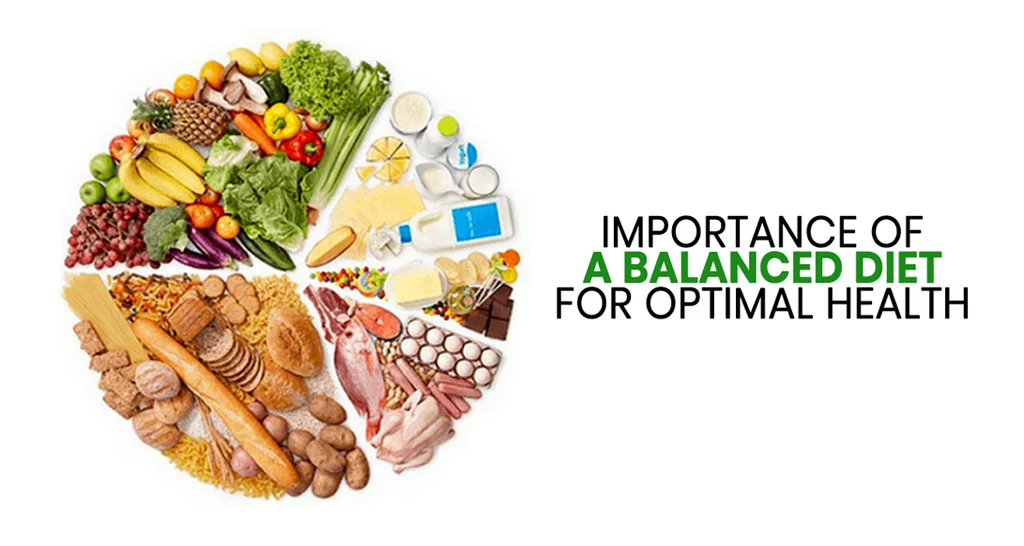Optimizing Health and Wellness:The Crucial Role of a Balanced Diet and Tailoring Nutrition to Individual Needs
Uncategorized Uncategorized
Optimizing Health and Wellness:
The Crucial Role of a Balanced Diet and Tailoring Nutrition to Individual Needs
A balanced diet refers to a meal plan that provides the body with the right nutrients, vitamins, and minerals it needs to function optimally. It involves consuming a variety of foods in appropriate proportions to maintain overall health and well-being. A balanced diet typically includes a combination of fruits, vegetables, whole grains, lean proteins, and healthy fats in the right .
It includes a mix of different food groups that offer various vitamins, minerals, carbohydrates, proteins, fats, and fiber. Designing a balanced diet involves choosing foods from different categories and ensuring moderation and diversity in your meals. Here’s an overview of each food group and examples of foods that contribute to a balanced diet:
1.Fruits:
– Include a variety of fruits such as apples, bananas, berries, oranges, kiwis, mangoes, and melons.
– Aim to consume whole fruits instead of fruit juices to benefit from the fiber content.
2. Vegetables:
– Incorporate a diverse range of vegetables like leafy greens (spinach, kale), cruciferous vegetables (broccoli, cauliflower), root vegetables (carrots, sweet potatoes), and others (bell peppers, tomatoes).
– Choose different colors to ensure a variety of nutrients.
3. Whole Grains:
– Opt for whole grains like brown rice, quinoa, oats, whole wheat bread, barley, and whole grain pasta.
– Whole grains provide fiber, vitamins, and minerals compared to refined grains.
4. Proteins:
– Include lean sources of protein like poultry (chicken, turkey), fish (salmon, tuna), tofu, legumes (beans, lentils), eggs, nuts, and seeds.
– Vary protein sources to get a broad spectrum of amino acids and nutrients.
5. Dairy or Alternatives:
– Incorporate dairy products such as milk, yogurt, and cheese, or their plant-based alternatives like almond milk, soy yogurt, and tofu.
– Choose low-fat or non-fat versions to reduce saturated fat intake.
6. Healthy Fats:
– Include sources of healthy fats such as avocados, nuts (almonds, walnuts), seeds (flaxseeds, chia seeds), and oils (olive oil, avocado oil).
– These fats provide essential fatty acids and aid in nutrient absorption.
A balanced diet involves portion control and moderation:
– Portion Control: Pay attention to portion sizes to avoid overeating. Use smaller plates, measure portions, and be mindful of serving sizes recommended for different food groups.
-Moderation: Enjoying occasional treats or foods high in sugar, salt, or saturated fats is acceptable, but in moderation. These should not dominate the diet.
Considerations for individual needs:
Age: Nutritional needs vary throughout life stages. Children, adults, and seniors require different amounts of nutrients.
Activity Level: Active individuals might need more calories and specific nutrients to support their energy expenditure.
Health Conditions: Certain medical conditions might require dietary modifications, like reducing sodium intake for hypertension or managing carbohydrate intake for diabetes.
Importance of a Balanced Diet:
1. Nutrient Supply: A balanced diet ensures the intake of essential nutrients like carbohydrates, proteins, fats, vitamins, and minerals that are necessary for various bodily functions.
2. Weight Management: It helps in maintaining a healthy weight by providing the body with the right amount of calories and nutrients.
3. Disease Prevention: A well-balanced diet reduces the risk of chronic diseases such as heart disease, diabetes, obesity, and certain cancers.
4. Improved Energy Levels: Proper nutrition supports optimal energy levels throughout the day, aiding in better focus and productivity.
5. Enhanced Mood and Mental Health: Certain nutrients in a balanced diet are linked to improved mental health, reducing the risk of depression and anxiety.
6. Healthy Growth and Development: For children and teenagers, a balanced diet is crucial for proper growth and development.
7. Better Digestive Health: Adequate fiber intake from fruits, vegetables, and whole grains supports healthy digestion and prevents constipation.
Benefits of a Balanced Diet for the Body:
1. Heart Health: A balanced diet low in saturated fats and cholesterol helps in maintaining healthy cholesterol levels, reducing the risk of heart diseases.
2. Strong Bones and Teeth: Adequate intake of calcium and vitamin D supports bone health, reducing the risk of osteoporosis.
3. Improved Immune Function: Nutrient-rich foods boost the immune system, helping the body fight off infections and illnesses.
4. Healthy Skin: Essential nutrients like vitamins A, C, and E obtained from a balanced diet contribute to healthy skin by protecting it from damage and promoting cell regeneration.
5. Muscle Strength and Repair: Protein-rich foods aid in muscle repair and growth, essential for athletes and individuals engaged in physical activities.
6. Regulated Blood Sugar Levels: A balanced diet with moderate carbohydrate intake helps in controlling blood sugar levels, reducing the risk of diabetes.
7. Better Sleep: Certain nutrients, like magnesium and tryptophan found in certain foods, contribute to better sleep quality.
the components of a balanced diet and elaborate on the importance and benefits of each aspect.
1. Nutrient Supply:
– Carbohydrates: They are the body’s primary source of energy. Complex carbohydrates from whole grains, fruits, and vegetables provide sustained energy and fiber.
– Proteins: Essential for growth, repair, and maintenance of body tissues. Sources include lean meats, fish, eggs, dairy, legumes, and nuts.
– Fats: Healthy fats like omega-3 and omega-6 fatty acids are crucial for brain function, cell growth, and energy. Sources include avocados, nuts, seeds, and olive oil.
– Vitamins and Minerals: Essential for various bodily functions, from supporting the immune system to aiding in metabolism. Fruits, vegetables, nuts, and dairy are rich sources.
2. Weight Management:
– A balanced diet focuses on portion control, ensuring you consume the right amount of calories for your body’s needs. It emphasizes nutrient-dense foods that keep you full for longer periods, reducing unnecessary snacking and overeating.
3. Disease Prevention:
– Heart Disease: Limiting saturated fats, trans fats, and sodium while increasing intake of fruits, vegetables, and whole grains can reduce the risk of heart disease.
– Diabetes: A balanced diet with complex carbohydrates and controlled sugar intake helps manage blood sugar levels, reducing the risk of type 2 diabetes.
– Cancer: Antioxidants and phytochemicals found in fruits, vegetables, and legumes can reduce the risk of certain cancers.
4. Improved Energy Levels:
– Balanced meals with a mix of carbohydrates, proteins, and fats provide sustained energy, preventing energy crashes throughout the day.
5. Enhanced Mood and Mental Health:
– Omega-3 fatty acids found in fish, walnuts, and flaxseeds are associated with improved mood and cognitive function.
– B vitamins from whole grains, leafy greens, and dairy contribute to brain health and mental well-being.
6. Healthy Growth and Development:
– For children and teenagers, a balanced diet rich in proteins, calcium, iron, and vitamins supports healthy growth, development, and learning.
7. Better Digestive Health:
– Fiber from fruits, vegetables, and whole grains aids in digestion, prevents constipation, and maintains a healthy gut microbiome.
8. Heart Health:
– Incorporating foods rich in omega-3 fatty acids (like salmon, chia seeds, and walnuts) and reducing intake of saturated fats and processed foods can support heart health.
9. Strong Bones and Teeth:
– Calcium and vitamin D from dairy products, leafy greens, and fortified foods are crucial for bone health and preventing conditions like osteoporosis.
10. Improved Immune Function:
– Antioxidants from fruits and vegetables, along with vitamins A, C, and E, support a healthy immune system.
11. Healthy Skin:
– Nutrients like vitamins A, C, and E, as well as antioxidants found in fruits, vegetables, and nuts, promote healthy skin by protecting against damage and aiding in cell repair.
12.Muscle Strength and Repair:
– Proteins from sources like lean meats, fish, eggs, and legumes are vital for muscle repair and growth.
13. Regulated Blood Sugar Levels:
– Choosing complex carbohydrates and avoiding excessive sugar intake can help maintain stable blood sugar levels.
14. Better Sleep:
– Foods rich in magnesium (such as leafy greens, nuts, and seeds) and tryptophan (found in turkey, chicken, and dairy) can aid in better sleep quality.
15. Customization to Different Lifestyles:
– A balanced diet can be customized to suit various dietary needs, including vegetarian, vegan, gluten-free, or specific cultural preferences, ensuring adequate nutrition for different lifestyles.
16. Meal Planning and Preparation:
– Planning meals in advance can facilitate a balanced diet. Preparing food at home allows control over ingredients, portions, and cooking methods, promoting healthier choices.
17. Hydration and Its Role:
– Water is essential for bodily functions, aiding in digestion, nutrient absorption, temperature regulation, and waste removal. Adequate hydration is a vital component of a balanced diet.
18. Understanding Portion Control:
– Even nutritious foods should be consumed in moderation. Understanding portion sizes helps in managing caloric intake and prevents overeating.
19. Long-Term Health Benefits:
– Consistently following a balanced diet not only provides immediate benefits but also contributes to long-term health and reduces the risk of chronic diseases later in life.
20. Building Healthy Eating Habits:
– Adopting a balanced diet fosters healthy eating habits in children and can positively influence their food choices as they grow, promoting a lifetime of good health.
21. Mindful Eating Practices:
– Being mindful while eating, focusing on the sensory experience and recognizing hunger cues, helps in better digestion and prevents overeating.
22. Balanced Diet for Specific Health Conditions:
– Tailoring a balanced diet to specific health conditions, such as hypertension or high cholesterol, can help manage these conditions effectively.
23. Avoiding Nutrient Deficiencies:
– A balanced diet ensures the intake of essential nutrients, reducing the risk of deficiencies that can lead to various health issues.
24. Improving Gut Health:
– Consuming probiotic-rich foods (like yogurt, kefir, and fermented vegetables) alongside fiber-rich foods supports a healthy gut microbiome, enhancing overall health.
25.Promoting Overall Well-Being:
– A balanced diet doesn’t just impact physical health but also contributes to emotional and mental well-being, promoting a sense of vitality and overall wellness.
26. Sustainability and Environmental Impact:
– Choosing a balanced diet that includes a variety of plant-based foods can have a positive impact on the environment by reducing the carbon footprint associated with animal agriculture.
27. Continuous Learning and Adaptation:
– As nutritional science evolves, staying informed about dietary recommendations and adapting one’s eating habits accordingly is crucial for maintaining a balanced diet.
In summary, a balanced diet is not just about counting calories but focuses on nourishing the body with a variety of nutrients from different food groups. Its benefits extend beyond physical health, impacting mental, emotional, and societal aspects of well-being. Adopting a balanced diet and making informed, healthy food choices is a cornerstone for a vibrant, healthy life.
The importance of tailoring a balanced diet to individual needs and the synergy between regular physical activity and a balanced diet for enhancing overall health and well-being:
1. Tailoring to Individual Needs:
Age: Dietary requirements vary across different life stages. Infants, children, adolescents, adults, and seniors have varying nutritional needs. For instance, seniors might need more calcium and vitamin D for bone health, while children and teenagers need nutrients for growth and development.
Activity Level: Individuals with high physical activity levels might need more calories, protein, and specific nutrients to support their energy expenditure and muscle recovery. Athletes, for example, require diets tailored to their training regimen and performance goals.
Specific Health Conditions: Certain health conditions, such as diabetes, hypertension, allergies, or gastrointestinal issues, may require dietary modifications. For instance, individuals with diabetes need to manage their carbohydrate intake to control blood sugar levels.
2. Synergy of Physical Activity and Balanced Diet:
Weight Management: Combining regular exercise with a balanced diet aids in weight management. Exercise helps burn calories, while a balanced diet ensures appropriate nutrition to support physical activity.
Muscle Strength and Endurance: Exercise, particularly strength training and aerobic exercises, complements a balanced diet by supporting muscle growth, improving endurance, and enhancing overall physical performance.
Metabolic Health: Regular physical activity, along with a balanced diet, contributes to better metabolic health by improving insulin sensitivity, lipid profiles, and reducing the risk of metabolic disorders.
Cardiovascular Health: The combination of a balanced diet and exercise helps in maintaining healthy blood pressure, cholesterol levels, and overall heart health.
Mental Health Benefits: Both regular physical activity and a balanced diet have positive effects on mental health, reducing stress, anxiety, and improving mood by releasing endorphins and promoting overall well-being.
Energy Expenditure and Nutrient Utilization: Physical activity increases energy expenditure and enhances nutrient utilization from the food consumed, optimizing the body’s efficiency in utilizing nutrients.
Longevity and Disease Prevention: The synergy between a balanced diet and regular physical activity is linked to a lower risk of chronic diseases, promoting longevity and overall health.
3. Creating a Holistic Lifestyle Approach:
Combining a tailored balanced diet with regular physical activity forms the basis of a holistic approach to health, promoting not just physical well-being but also mental and emotional wellness.
Embracing healthy eating habits and an active lifestyle creates a positive feedback loop, where one aspect reinforces and supports the other, leading to overall improved health and vitality.
In conclusion, recognizing individual nutritional needs and integrating regular physical activity with a balanced diet are key components of a holistic approach to health. This personalized approach contributes significantly to achieving and maintaining optimal health, vitality, and overall well-being across different life stages and varying health conditions.
admin
Related Posts
The Future of Personalized Medicine: DNA-Based Diets and Treatments
Introduction The medical field is shifting from a uniform approach to personalized treatments. Advances in genetic research now enable healthcare providers to tailor care based on an individual’s DNA. One key development is DNA-based diets and treatments. By analyzing genetic

Understanding the importance of SEO – Geeta University
Understanding the importance of SEO – Geeta University In today’s digital age, it’s necessary for businesses to create a strong online presence. With more and more consumers turning to the internet to search for products and services, it’s important for

What Are the Career Options for A Law Graduate In India – Geeta University
The legal profession in India has undergone numerous changes over the years. Lawyers are no longer confined to the courtroom where they represent their clients. Law graduates today work in a variety of settings, including corporations, IT firms, administrative services,


